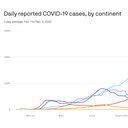U.S. sets new coronavirus records while Europe bends the curve

While the U.S. continues to set records for new coronavirus cases, European countries have managed to turn their own terrifying spikes around.
The big picture: As some states in the U.S. crack down to head off the worst, the debate in countries like the U.K. and France has shifted to whether and how to lighten their own restrictions before the holidays.
- America's surge lagged two to three weeks behind Europe's, with a similarly worrying trajectory. However, responses in U.S. states have been uneven and generally less severe than in most European countries.
- Daily case counts are already rising significantly in most U.S. states, and they're likely to tick up further following Thanksgiving gatherings around the country.
Much of Europe returned to some form of lockdown in the fall, but the restrictions tended to be less restrictive than in the spring. They certainly haven't been in place as long.
- Many countries closed bars and restaurants, and nearly all at least limited their opening hours. Social gatherings were also limited — in Germany's case, to groups of up to five from a maximum of two households (children are exempted).
- But schools have remained open across nearly all of the continent, and the disruption to economic activity, while highly significant, hasn't been quite as severe (though many governments have faced anti-lockdown protests).
The fact that countries like Italy were able to bend the curve so quickly with partial lockdowns is encouraging, says Stephen Kissler, a researcher at Harvard who models the spread of diseases, including COVID-19.
- "The evidence shows that these full lockdowns we underwent in the spring aren't necessary now," he says.
- "We have so much more information now that we can respond a lot more quickly and in a more targeted manner — really just shutting down the types of activities that contribute most to the spread."
Test positivity rates are falling significantly in many EU countries — another sign that the current wave is subsiding.
- In Belgium, for example, the positivity rate fell from 21% to 8% over the past three weeks, with similar trends in France and the Netherlands.
- The outlook is a bit darker in Central Europe. The Czech Republic still has a positivity rate of 21%, while Poland's 49% rate is higher than every U.S. state but Idaho.
Reality check: Europe is far from out of the woods. Deaths and hospitalizations lag behind spikes in cases, and those numbers are falling much later and less sharply.
- Italy recorded a record-high death toll on Thursday, three weeks after case numbers peaked.
- And while the trajectory on cases is positive, public health experts fear a swift reversal if countries open up too quickly.
Governments in the U.K., France and elsewhere had promised the measures would be temporary and Christmas celebrations would still be possible. They're now attempting a difficult balancing act with the virus still spreading rampantly.
- The U.K. is introducing the "Christmas bubble," which will allow up to three households to gather together over the Christmas period.
- Spain is increasing the maximum gathering size from 6 to 10.
- Germany plans to tighten restrictions through Dec. 20 and then allow groups of up to 10 to gather.
The bottom line: In Europe, those decisions are being made with cases on the decline and the outlook improving. That's not the case in the U.S.